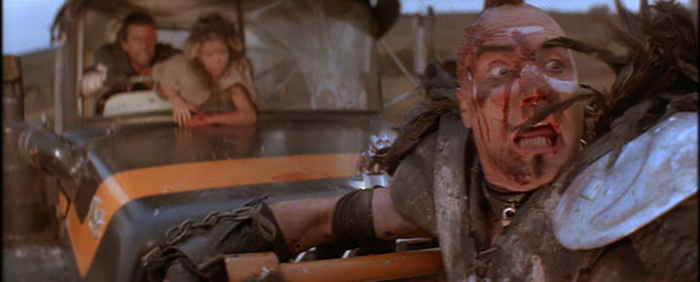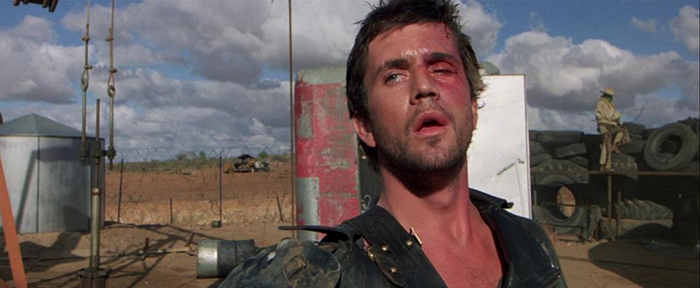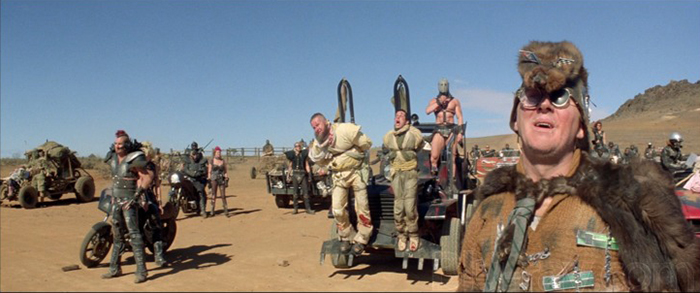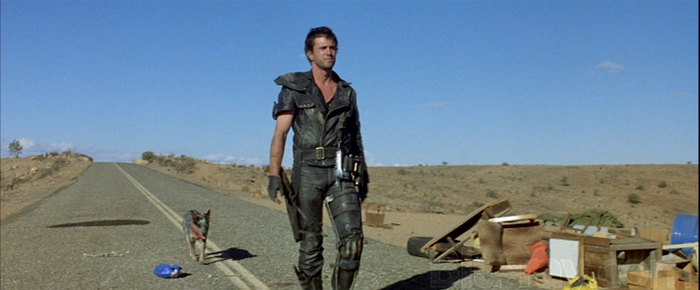I don't think it's an overstatement to proclaim Mad Max: Fury Road a cinematic miracle. In fact, I'd say that's selling it short. Usually after waiting for a fresh entry in a landmark movie series for 29 years and 309 days, you're either resigned to disappointment or forced to accept some underwhelming mediocrity. At best you get a Tron: Legacy, at worst you get an Odd Couple II. And when the original director returns, he risks tainting the reputation of the original films - do I even have to mention Mother of Tears or The Wicker Tree? (Fight amongst yourselves as to whether Pistol Opera applies.)
So here's George Miller, a man twice the age of your average big scale Hollywood director, delivering Fury Road, a reboot that not only stands proudly next to its legendary cinematic ancestors but pretty much decimates any other action movie of the last 20 years. While the terminators and the Avengers and the furiousers and the jurassics received enthusiastic returns, 2015 is unquestionably the summer of Mad Max. To celebrate, I knew I had to include one of the three Max adaptations in this Summer of Novelizations project.
Although Joan Vinge's Mad Max Beyond Thunderdome is more readily available than the novelizations of the first two films, both of which only came out in Australia and are long out-of-print, I knew a Thunderdome-based review just wasn't going to ciphon the gazzolene required for a true, adrenaline-fueled Max tribute. So I sent a postal order down under and, three weeks that moved at the speed of the Gyro Captain handcuffed to a tree branch later, received Terry Hayes' rendering of The Road Warrior, published in 1982 by QB Books under the film's original if less inventive title, Mad Max 2.
Terry Hayes is the co-writer of the Road Warrior screenplay - before that he authored the novelization of the first Mad Max (script by Miller and James McCausland). In fact, novelization duty actually led to a career in this case: apparently George Miller was so impressed by his first take on the Maxiverse that he hired Hayes to co-write the script for the sequel. Hayes went on to work with Miller for the next 10 years, co-producing and co-writing Thunderdome, co-producing his own adaptation of Dead Calm and co-producing John Duigan's The Year My Voice Broke and Flirting (later he'd rewrite Payback after Brian Helgeland was fired by Mel Gibson). Sadly I haven't read his novelization of the original Mad Max, which must have been something to make that kind of impression on the director. Considering the differences in the worlds of Mad Max 1 and 2, I'd be curious to know how much of the iconic post-apocalypse world of Road Warrior came directly from Hayes.*
Something else I wondered before cracking open the book was whether or not it would be narrated by the future, aged Feral Kid, who provides the bookend narration of the movie. Not only is that not the case, Hayes foregoes the film's prologue/epilogue entirely in favor of keeping the action with Max, presumably so as not to confuse the reader during events that take place without F.K. witnessing them (something much easier to get away with on celluloid). The result is that the novelization loses the mythological feel of the movie, opting for a more straight-forward action narrative.
At first, this seemed like an instant dealbreaker. I mean think about it. The film creates a unique timelessness by setting the story in an unthinkable future that's grounded by the audience's knowledge of the past, while also introducing a voice-over that establishes that this is the past. Driven back to a primitive culture based on scavenging for survival, Miller's world is populated by noble warriors like medieval knights and groups of people collectively known as "tribes," their adventures passed down in the form of a saga from one generation to the next. Every familiar item in the film takes on a special significance because of this approach: the souped-up, weaponized vehicles become the chariots of gods, a mint-condition firearm in a special case has the ethereal power of Excalibur. The characters and their struggle feel epic, and steeped in cinematic history - the chases are akin to old stagecoach assaults, the siege on the refinery to the fabled last stand at the Alamo, or the Zulu impis charging Rorke's Drift. "The warrior Max" ventures forth like the ancient hero, "battered and smashed" but finding redemption in a patchwork civilization where past and future are both obscure and ubiquitous. Take that away and you kind of lose part of what's special about the movie.
But scaling it down does end up largely working in the novelization's favor, especially the first 50 or so pages before Max joins the colony at the fortified compound. The focus becomes less on developing the world of the wasteland and more on the non-stop action, with Hayes opting to write in present tense. This kind of writing can quickly turn disastrous if done poorly, but Hayes manages to keep the narrative in high gear and maintain a staggering immediacy throughout all of the dialogue-free sections of the book. Anyone who's seen the movie knows that there's something exciting happening at any given moment: besides its three major car chases, there are stand-offs and desperate escapes, rising tensions and in-fighting within the compound, boomerang back-and-forth, side characters in constant peril and Max with weapons constantly pointed at him by basically everyone else in the movie. Hayes makes the most of the movie's breakneak thrills by matching it with frantically-paced, real-time writing that results in fragmented bursts of action and intense, paragraph-long, 150-word sentences that leave the reader convinced that the present is all that exists in this unrelenting reality. The past is gone and there may not be a future ("Ceaseless movement on and on...and shit, there wasn't a future. Why think about the future? All the lights had long been turned off.")
There may not be a past, but Hayes offers some interesting background on the Max-world during some of the hero's personal moments of reflection. Apparently when society started to crumble, Armalite gangs (named after their weapon of choice), set out from the cities to ambush the country's long-haul truckers on the Transcontinental One. Their activities caused the price of consumer goods to rise, a great blow to the All-National Retail Corporation who eventually declare the major roads off-limits. Meanwhile the Central Bureaucracy formed the Breaker Squad, an elite group of highway patrol cops acting under the Main Force Patrol, to break the gangs' strangehold on the Transcon One. Max is one of the original recruits, making it through a two-week training period with 89 out of 100 officers (the others died in car crashes) with additional training provided by the Special Commando Task Force.
The cataclysm that occurs somewhere between Mad Max 1 and 2 remains vague, although Hayes mentions Max's boss, ol' Fifi Macaffee, losing control of the MFP shortly after Max's wife and son are killed,** right before society fell apart altogether. Hayes has images from Max's past (his wife Jessie, Captain Macaffee... strangely the Goose doesn't come up) superimposed on the highway, speaking to the road warrior as he speeds further into the wasteland but never far enough away. It's an interesting device, similar to the phantoms of the little girl and other members of Max's old, presumably decimated tribe that pop up intermittently in Fury Road. Flashbacks describe the first film's run-in with the Nightrider in detail, making me wonder how much of it is word-for-word from Hayes' novelization of the original movie.
"This is the present. The Nightrider belongs to the past, as Jessie and Sprog belong to the past."
Hayes isn't completely averse to sprinkling a little mythology into his book: the second chapter dives right into Lord Humungus [note: this is how Hayes spells the name so I'm following suit], who we learn already has a reputation across the wasteland as a "viking and vandal." Max has heard rumors about him, but doesn't know what he looks like until he arrives at the compound, and since Hayes commits to sticking with Max we get no additional background into the Ayatollah of Rock 'n Rollah - he doesn't even recite Goethe's "Der Erlkönig." He does, out of necessity, provide some insights into Humungus' gang, its various sectors identified as:
- Mohawk Bikers
- Smegma Crazies in dune buggies
- Gayboy Berserkers in street racers
- the Skinheads in two toe trucks
- the Jap monsters
- the Trikes
- miscellaneous camp followers
I haven't gone back and compared the novel to the shots of the Humungus bunch in the movie, so I'm not sure how closely they compare. Last time I saw the film, I kind of figured the Smegma Crazies were the ones in the masks, but one of them takes his off and has a mohawk so I dunno. I'm sure Humungus has a system too complicated for me to comprehend. Fortunately we don't learn why they're called "Smegma Crazies" - I mean, I don't know if the word means something different in Australia, but as far as I know "smegma" only refers to exfoliated epithelial cells and transudated skin oils between the foreskin and the penis. I'm sure Miller enjoyed a chance to tap into some terminology from his old days as a physician, but yikes!
One hurdle Hayes never quite clears is constantly having to actually refer to generic members of the gang as "the Gayboy Berserker" and "the Bearclaw Mohawker." The book can't fly on its own without visual cues from the movie in moments such as Max turning around and finding himself face-to-face with "a Smegma Crazy." (If you've never seen The Road Warrior but know what "smegma" means you'll probably just be grossed out.) But he does a good job establishing an order among the outlaws, detailing how one representative from each faction surrounds Lord Humungus as part of his inner circle (sort of like the People Eater from Gas Town and the Bullet Farmer flanking Immortan Joe in Fury Road). Hayes has an excellent grasp of the group dynamic, detailing the stripping of car parts, how victors quickly strip everything from the vanquished like a wake of vultures. He includes an attack on the compound with a crude ladder/ramp that didn't make it into the movie yet, surprisingly, a scene from the final draft of the screenplay that introduces Wez on a farm he and his droogs have just ravaged is absent from the novelization.
Wez, alternatively referred to by Hayes as "Mohawk with the crimson swatch" and at one point described as clinging onto a truck "like a limpet", is portrayed as adequately savage without the benefit of Vernon Wells' bug-eyed performance. Reportedly, Wells once stated that Wez and the Golden Youth perched on the back of his motorcycle weren't lovers, that there was a deleted scene which explained that Wez rescued Golden Youth as a child and became a sort of surrogate father to him.*** But Hayes clears up any ambiguity by presenting the youth as sensually as his name suggests: "Almost naked, the pillion passenger is tightly hugging the rider...his long golden hair being whipped back by the airstream." Then later, after the Youth has fallen prey to Feral Kid's deadly boomerang, Hayes makes his relationship with Wez even more explicit: "The howl that is loosened by the crimson Mohawker when he has seen what has happened to his lover is unreal, unearthly. It tingles the spine."
As for the survivors at the plant, they're more or less as undistractingly one-note as they are in the movie**** with one glaring exception. See, every novelization has its eccentricities - for Hayes these are his depictions of the lead female characters. You may remember, there are two in the movie: the headband-rocking archery enthusiast "Warrior Woman" and the younger, chubby-cheeked, top-knot hair gal who ends up with the Gyro Captain. Apparently Hayes had a bit of a Frazetta fantasy in mind for the character of the Warrior Woman, who he describes as wearing "skins... only just covering her superb, thrusting breasts." Miller resisted such fetishistic features and literally covered her head-to-toe, even adding a bulky cowl neck to conceal everything beneath the chin, with football pads guarding her entire chest area.*****
But Hayes clearly had a Raquel Welch-in-One Million Years B.C. vision of the character, that much is clear. His rendering of the top-knot girl, however, is downright sleazy. In his mind, she's got "a provocative pout to her full red lips. Her rounded breasts rise and fall in effortless rhythm, her figure is ripe and voluptuous. She is a creature of lust and abandon." Hayes christens her "The Lusty Girl" (the character is billed as "The Captain's Girl" in the film's credits, although she is referred to as "The Lusty Girl" in the screenplay), and every time he comes back to her he just can't help but focus on a particular part of her anatomy:
"The lusty girl is by [the curmudgeon's] side, her breasts firm and ripe, nipples pushing against the thin fabric of her shirt."
"The lusty girl's shirt is open all the way down to her navel, revealing the smooth inner flanges of her breasts almost to the tips."
Keep in mind, this is all before the Gyro Captain comes to camp and starts ogling her! And I doubt even G.C., who decorates his 'copter's vertical stabilizer with a Playboy centerfold, is as into her as Hayes appears to be. Once the Captain has arrived in the camp, Hayes doesn't let up: "She nuzzles closer to him, and looks up into his eyes. Her breasts are so round, so firm. 'Our problems must look awful small from up there,' she says in a small voice." Granted, when we first see this character in the movie she's got her shirt open down to her chest, but there's never a hint of cleavage and in later scenes she's even more covered-up than the Warrior Woman. More worryingly, based on the film I wouldn't be surprised to learn she's supposed to be 15, 16 years old (actress Arkie Whiteley, who was also in Razorback and sadly died aged 37, would have been about 16 at the time).
It's fine though - Miller just decided to go in a different direction with the character, I suppose. Hayes obviously saw her as a pin-up, present at the compound to remind the refinery fighters what it is they've got to look forward to at that beach where there's "nothin' to do but breed." (Hayes published his first original novel, the well-received I Am Pilgrim, in 2013 - I wonder how many mentions of gals' mammaries can be found in that book.)
Once the story gets settled at the compound, the urgency of Hayes' present tense narrative somewhat sputters out and it reads more like a screenplay. After several pages of argument within the good guy camp, it takes less than two pages for Max to propose his plan (he says "Hey!" instead of whistling - Hayes gives Max several extra lines throughout the book in general), negotiate his fee and set off to retrieve the prime mover to haul the tanker. To be fair, this happens pretty quickly in the movie as well, but Hayes still seems impatient to get back to the battles on the road. He sticks with Max for a majority of the book, shifting perspective only when there's important action Max couldn't be observing.
This means a loss of some profound minor moments like Max tapping the tanks to check for oil and the toadie chuckling after getting his fingers cut off by the Feral Kid's boomerang (he does mention the throbbing vein on the back of Humungus' head). Additional credit for the screenplay was given to Brian Hannant, who also served as first assistant director and second unit director on the film. The second unit work plays a huge part in what makes Road Warrior great, and I suspect Miller was so floored by the little details evident in Hannant's work that he decided to give him a writing credit. As back-handed as this might seem, I appreciate the novelization for making me aware of that contribution.
One part from the movie that I missed in the book was the Gyro Captain watching the rape of the woman from the dune buggy through binoculars. He can't help but look, finding the sight of naked breasts arousing, and you can't blame him - it's probably been a good long while since he's seen a anything like that. He lowers the binoculars, then raises them again, finally sort of accepting that there's nothing he can do to help this poor lady so he might as well see some action. Then the marauder stands over the girl with a crossbow and launches an arrow straight down into his victim's body, and it cuts to one of my favorite shots in the movie: the Captain bringing down the binoculars, aghast, kind of sickened not only by the horrible act of violence but by his own indirect culpability in enjoying it up until the final second when it turns decisively dismal. It's a moment that temporarily makes the the Captain more than just the comic relief/Deus ex machina provider that also underlines the desperate situation of the marauders' victims. Since we're stuck in Max's angle,****** Hayes only has the G.C. "breathing heavily" and judiciously interjecting that "once or twice, he swears under his breath." This, from the writer who couldn't write enough about the Lusty Girl's heaving bosom?
Hayes makes up for it later by not failing to depict one of the film's most random and bawdy asides. Although it's kind of ridiculous that Max would have noticed it during a frantic life-and-death chase, Hayes makes sure to include Max's vehicle knocking down the tent to reveal the biker couple in mid-coitous, a detail I'm sure Richard Lester would be happy about.
In a very similarly-penned instance, Max is barreling towards the compound for the first time when he catches a glimpse of something in the mirror, "too large to be a rabbit - maybe some other sort of animal." This of course is the Feral Kid, but that fleeting glance of him in the rearview is as detailed a portrait as Hayes is willing to provide. I'm a big fan of the internet theory that Tom Hardy's character from Fury Road isn't the same Max Rockatansky as Mel Gibson's, that he may in fact be an adult version of the Feral Kid, hence his excessive grunting and reluctance to give his name.
A telling trinket supporting this hypothesis is the tiny hurdy-gurdy music box that Max gifts to the Kid in Road Warrior, which pops up again in Fury Road. It would fit so well in George Miller's mythology to have the Max mantle be indirectly handed down to someone else (the "Max" moniker almost becomes a sobriquet in the series anyway, with only the annoying scene where Papagallo calls Gibson "Max" three times in a row making it formal in Road Warrior.) Sadly, Hayes offers nothing to shed any light on this possibility and the Kid's even more of a mystery in the novelization, which actually further frustrates the theory: in the book, Max does not toss the hurdy-gurdy to Feral Kid, he pockets it after playing it for him. Oh well, it was a long shot.
However, Feral Kid becomes even more the center of attention in the finale of the book, which makes the most significant change from its cinematic source. During the crowning chase, the Kid falls off the tanker, gets chased down by cars, then at the last minute a ladder drops from the gyrocopter and he's taken up into the air. When the gyrocopter gets hit, the Kid is grabbed by Max onto the truck as the 'copter crashes down; we never hear from the G.C. again until the brief final chapter when he turns up to join the expedition moving north (in the book Humungus shoots off the Gyro Captain's right foot - it's clear in the movie that he wounds G.C., but it doesn't seem like anything debilitating). Feral Kid gets pinned to the truck with an arrow to the arm. Max, unaware of this, jumps off the truck onto Pappagallo's lone wolf machine and they speed off. Humungus, Wez and a Mohawker discover there's only sand in the tanker; in response, Wez sez "I know where there's guzzolene," then immediately turns and fires an arrow into Humungus' head!
"And thus, quietly, without fuss, the great and mighty Humungus is carried off to what destiny awaits him. It is very quick. The Humungus doesn't even make a sound of protest as he crumbles to the ground, thoroughly dead."
Wez and four others (all Mohawkers?) then turn on their fellow marauders and slaughter them, intending to take the gas from all their vehicles and start up a new squad, with Wez declaring: "I am the Humungus - Warrior of the Wasteland!" when Max finds out F.K. is still alive, he kicks Pappagallo out of the lone wolf, turns it around and heads back, only to find Wez driving Humungus' vehicle with F.K. strapped to his car upside down. A somewhat anticlimactic chase ensues, ending when Max fires a random arrow just as Wez sets off the nitrous oxide to accelerate and manages to put it through the crimson Mohawker's eye and bring the tank to a stop.
Wez's betrayal of Humungus makes sense - in both book and film, it seems like the puppy is destined to bite the hand of the master - and the book's differences pretty much serve the same narrative purpose: Feral Kid in danger from Wez, the tanker revealed to be filled with sand, etc. But we lose Pappagallo's cool death by trident, the explosive collison between the trunk and Humungus' war machine with Wez trapped inbetween and Max doesn't get to discover the sand pouring from the tanker. In fact it's never indicated in the novelization that Max wasn't in on the big ruse, which is what makes the end of the movie so fucking cool - that all the death and destruction of the final 15 minutes have literally been for nothing. Still, Hayes kicks things back into high gear for that final stretch of action and his work on the novelization hardly comes to nothing. And in the fullness of time, perhaps it will finally see publication in the states and become a required text for all schools of badassdom.




